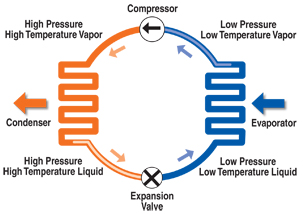The Condenser/Evaporator: You Have To Change That Phase
The condenser is located downstream from the compressor on the exterior of the refrigerator. It's purpose is to change the phase of the now hot, gaseous, refrigerant to a cooler, yet still relatively hot, liquid phase. This is an integral part of the refrigeration system. The more heat transferred from the condenser to the surroundings, the cooler the expansion valve and evaporator will be able to make the insulated compartment of the refrigerator.
The thermodynamic properties of the refrigerant cause it to become liquid at cooler temperatures. In the condenser, the surface area is maximized to allow as much heat as possible to transfer from the condenser to it's surroundings. Once the refrigerant passes through the various twists and turns of the condenser, it passes through the expansion valve and onto the evaporator.
The evaporator works opposite to the condenser in that it allows the liquid refrigerant inside it to absorb the warmth inside the insulated compartment. While absorbing this heat energy the liquid refrigerant changes phase to a gas. This cool gas flows to the pump and the refrigeration cycle begins again.
The thermodynamic properties of the refrigerant cause it to become liquid at cooler temperatures. In the condenser, the surface area is maximized to allow as much heat as possible to transfer from the condenser to it's surroundings. Once the refrigerant passes through the various twists and turns of the condenser, it passes through the expansion valve and onto the evaporator.
The evaporator works opposite to the condenser in that it allows the liquid refrigerant inside it to absorb the warmth inside the insulated compartment. While absorbing this heat energy the liquid refrigerant changes phase to a gas. This cool gas flows to the pump and the refrigeration cycle begins again.
